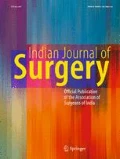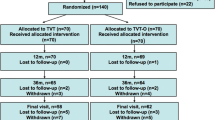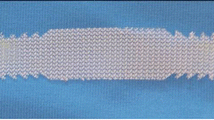Abstract
Voiding dysfunction is one of the most common postoperative complications of the tension-free vaginal tape procedure. The aim of this study was to show the effectiveness of loosening the tape with a simple approach. A total of 84 women underwent a tension-free vaginal tape operation for stress urinary incontinence. While operation was performed, a prolene suture–safety stitch was inserted in the middle of the tape. Then vaginal incision was closed by extracting the prolene stitch outside. Thus prolene suture will be pulled with a clamp when patient complaint of voiding dysfunction at the postoperative period. A total of 18 patients (21.4%) experienced voiding dysfunction at the postoperative 1-month follow-up period. Sixteen patients (%19) were performed transvaginal tape mobilization within 3 days (range 1–5) after the primary procedure. No complications were observed with the mobilization. Two patients(2.3%) performed clean intermittent catheterization for a period of more than 1 day, with an average of 14.4 days (range 3–63). After tape mobilization, 15 women (93.7%) were recovered from voiding dysfunction and were continent. One woman was incontinent after mobilization. The incidence of voiding dysfunction requiring tape mobilization was 19%. Pulling the safety stitch without anesthesia and without reopening the vaginal incision is a simple, safe, and effective way for tape mobilization to relieve voiding dysfunction.
Similar content being viewed by others
References
Dmochowski RR, Blaivas JM, Gormley EA, Juma S, Karram DJ, Lightner DJ (2010) Update of AUA guideline on the surgical management of female stress urinary incontinence. J Urol 183:1906–1914
Karram MM, Segal JL, Vassallo BJ, Kleeman SD (2003) Complications and untoward effects of the tension-free vaginal tape procedure. Obstet Gynecol 10:929–932
Ulmsten U, Petros P (1995) Intravaginal slingplasty (IVS): an ambulatory surgical procedure for treatment of female urinary incontinence. Scand J Urol Nephrol 29:75–82
Ulmsten U, Henriksson L, Johnson P, Varhos G (1996) An ambulatory surgical procedure under local anesthesia for treatment of female incontinence. Int Urogynecol J 7:81–86
Klutke C, Siegel S, Carlin B, Paszkiewicz KA, Klutke J (2001) Urinary retention after tension-free vaginal tape procedure: incidence and treatment. Urology 58:697–701
Wang KH, Neimark M, Davila GW (2002) Voiding dysfunction following TVT procedure. Int Urogynecol J Pelvic Floor Dysfunct 13:353–357
Dawson T, Dawson V, Adams E, Richmond D (2007) Factors predictive of post-TVT voiding dysfunction. Int Urogynecol J Pelvic Floor Dysfunct 18:1297–1302
Kuuva N, Nielsson CG (2002) A nation-wide analysis of complications associated with the tension-free vaginal tape (TVT) procedure. Acta Obstet Gynecol Scand 81:72–77
Shoebeiri SA, Nihira MA Attachment of a sling rescue suture to mid-urethral tape for management of potential postoperative voiding dysfunction. Neurourol Urodyn 28:990–994
Nguyen JN (2005) Tape mobilization for urinary retention after tension-free vaginal tape procedures. Urology 66:523–526
Glavind K, Shim S (2015) Incidence and treatment of postoperative voiding dysfunction after the tension-free vaginal tape procedure. Int Urogynecol J 26:1657–1660
Glavind K, Glavind E (2007) Treatment of prolonged voiding dysfunction after tension-free vaginal tape procedure. Acta Obstet Gynecol Scand 86:357–360
Madhuvrata P, Ford J, Merrick K, Boachie C, Abdel-Fatah M (2011) Voiding dysfunction following suburethral tape. J Obstet Gynaecol 31:424–428
Duckett JRA, Patil A, Papanikolau NS (2008) Predicting early voiding dysfunction after tension-free vaginal tape. J Obstet Gynaecol 28:89–92
Rautenberg O, Kociszewski J, Welter J, Kuszka A, Eberhard J, Vierick V (2013) Ultrasound and early tape mobilisation—a practical solution for treating postoperative voiding dysfunction. Neurourol Urodyn 33:1147–1151
Price N, Slack A, Khong S, Currie I, Jackson S (2009) The benefit of early mobilisation of tension-free vaginal tape in the treatment of post-operative voiding dysfunction. Int Urogynecol J 20:855–858
Authors’ Participation
Adeviye Elçi Atılgan designed, wrote, and revised the study.
Şükriye Leyla Altuntaş collected patients data.
Author information
Authors and Affiliations
Corresponding author
Ethics declarations
Conflict of Interest
The authors declare that they have no conflict of interest.
Additional information
Publisher’s Note
Springer Nature remains neutral with regard to jurisdictional claims in published maps and institutional affiliations.
Rights and permissions
About this article
Cite this article
Elçi Atilgan, A., Altuntaş, Ş.L. A Simple Approach for Relieving Voiding Dysfunction After Tension-Free Vaginal Tape: Safety Stitch. Indian J Surg 83, 1241–1244 (2021). https://doi.org/10.1007/s12262-020-02652-7
Received:
Accepted:
Published:
Issue Date:
DOI: https://doi.org/10.1007/s12262-020-02652-7




